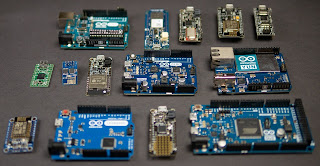Arduino is an open-source electronics platform based on easy-to-use hardware and software. Arduino boards are able to read inputs - light on a sensor, a finger on a button, or a Twitter message - and turn it into an output - activating a motor, turning on an LED, publishing something online. You can tell your board what to do by sending a set of instructions to the microcontroller on the board.
In the computers and other devices we are using micro processors.
There are many differences between micro processors and micro controllers.
When talking about the Arduino Micro controller takes a major place. Because Arduino boards are consists of Atmel micro controllers.(Atmel Chips)
From this Arduino boards there are many new creations that can be build. It is an easy task to build robots using Arduino. Because the programming as well electronics is easy rather than using other embedded systems.
There are many Arduino Boards which we can work.
Arduino Uno
Arduino Nano
Arduino Mega
Are some examples for Arduino boards.
There are many creations that we can build from this boards with the help of sensors and shields.
Through this web site we are going to raise your Arduino knowledge from basic level to the advanced level. So stay with us to gather knowledge.
See you in the next post.....
--------Tech Boy-------- 2019/12/04
What is a microcontroller?
A microcontroller (MCU for microcontroller unit) is a small computer on a single metal-oxide-semiconductor (MOS) integrated circuit chip. In modern terminology, it is similar to, but less sophisticated than, a system on a chip (SoC); an SoC may include a microcontroller as one of its components. A micro-controller contains one or more CPUs (processor cores) along with memory and programmable input/output peripherals
In the computers and other devices we are using micro processors.
There are many differences between micro processors and micro controllers.
When talking about the Arduino Micro controller takes a major place. Because Arduino boards are consists of Atmel micro controllers.(Atmel Chips)
From this Arduino boards there are many new creations that can be build. It is an easy task to build robots using Arduino. Because the programming as well electronics is easy rather than using other embedded systems.
There are many Arduino Boards which we can work.
Arduino Uno
Arduino Nano
Arduino Mega
Are some examples for Arduino boards.
There are many creations that we can build from this boards with the help of sensors and shields.
Arduino 3D printer
Arduino Obstacle Avoiding Robot
Arduino Line Follower
Arduino CNC plotter
Through this web site we are going to raise your Arduino knowledge from basic level to the advanced level. So stay with us to gather knowledge.
See you in the next post.....
--------Tech Boy-------- 2019/12/04









Comments
Post a Comment